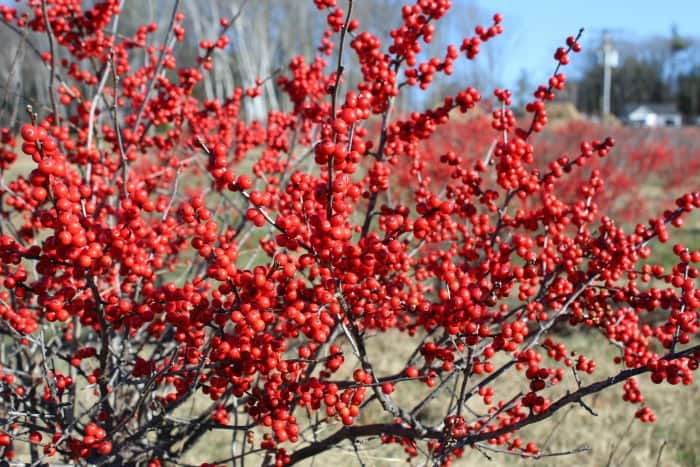Winterberry is a beautiful and versatile shrub that has many uses in nature, in your landscape, and even inside your home.
Winterberry (Ilex Verticillata), is a deciduous, holly shrub, that is native to the North Eastern United States. It’s best known for its bright red berries that it forms in late fall/winter.
Winterberry shrubs are dioecious, meaning individual plants are either male, or female. To produce berries, a male and female plant need to be in close proximity (100 feet or less).
At a time of year when landscapes are looking bleak in colder climates, the bright red berries produced by Winterberries come to the rescue. Their color is even more pronounced with a snowy white backdrop.
Garden centers are usually loaded with cut Winterberry stems covered in berries right around Thanksgiving. It’s a clear sign that it’s time to ring in the holiday season.
But before cut branches make it into floral arrangements and holiday decor, Winterberry shrubs are pretty inconspicuous. They spend most of the year blending into the landscape with their green foliage and upright branching habit.
Winterberry Size
Winterberry can grow 3′-12′ tall and wide depending on the variety and environmental conditions.
Is Winterberry Evergreen or Deciduous
Unlike most hollies seen in northern gardens, Winterberry (Ilex Verticillata) is a deciduous shrub.
Growing Zone
Zones 3-9. Check your growing zone.
Sunlight
Winterberry grows in full sun to moderate shade. For the best foliage, and berry production, plant in full sun.
Soil Conditions
Adapts to a lot of different soil conditions but does best in moist soils with a lot of organic matter. They also prefer acidic soils with a pH of 4.5-6.5. Winterberry also tolerates boggy, swamp like conditions, which is where it is most likely to be seen in nature.
Pruning Winterberry
Light pruning will help to maintain shape and size and create a thicker branching habit. This can be done in early spring, with an easy to use hedge trimmer or pruning shears. Since Winterberry flowers and produces berries on new wood it is safest to prune in early spring before new growth appears. If you prune right before or during flowering you will not have any berries in fall.
It’s also a good idea to remove dead and diseased branches, crossing branches, and weak branches. For this type of pruning you need to make precision cuts so be sure to use a good bypass pruner.
Flower
Winterberry flowers from April-July. Its small greenish white flowers are relatively unimpressive, however pollinators will benefit from them. Only pollinated female flowers will produce the berry fruit.
Uses
Winterberry is very versatile. In nature, Winterberry berries are a great source of food for birds and other wildlife. Since they can tolerate wet conditions they are an important part of wetland ecosystems.
In the landscape they are commonly used in rain gardens, and areas along streams and rivers. They can also be used in shrub borders, foundation plantings, and hedges.
Their bright red berries are a staple for the winter holidays. They are often used in floral arrangements, wreaths, and other home decor.
Common Varieties
*Ilex Verticillata ‘Red Sprite’ – One of the more common varieties, and also one of the more compact. Typically grows 3-5 feet and has a very dense branching habit.
* lex Verticillata ‘Winter Red’- Probably the most popular Winterberry. This variety grows taller then most (8′-9′). Produces an abundant amount of berries.
*Ilex Veticillata ‘Winter Gold’- If you’re looking for a little variation in berry color then this variety is a good choice. It’s pinkish to orange berry color is a nice change from the standard red. General height for a mature shrub is 5′-8′.
Problems
Winterberry is not prone to many problems. On occasion powdery mildew or leaf spot can occur. Also since Winterberry prefers acidic soil if planted in soil that is too basic it could suffer from chlorosis.
Winterberry Toxicity
Although not considered extremely toxic, it is classified as mildly poisonous to humans and many animals including dogs and cats.
Check Out These Posts Next
Fall Gardening: Tips and Maintenance
Protecting Evergreens from Winter Burn
Follow Me
Join my free email list!
Plus, follow me on Facebook, Instagram, and Pinterest.



Leave a Reply